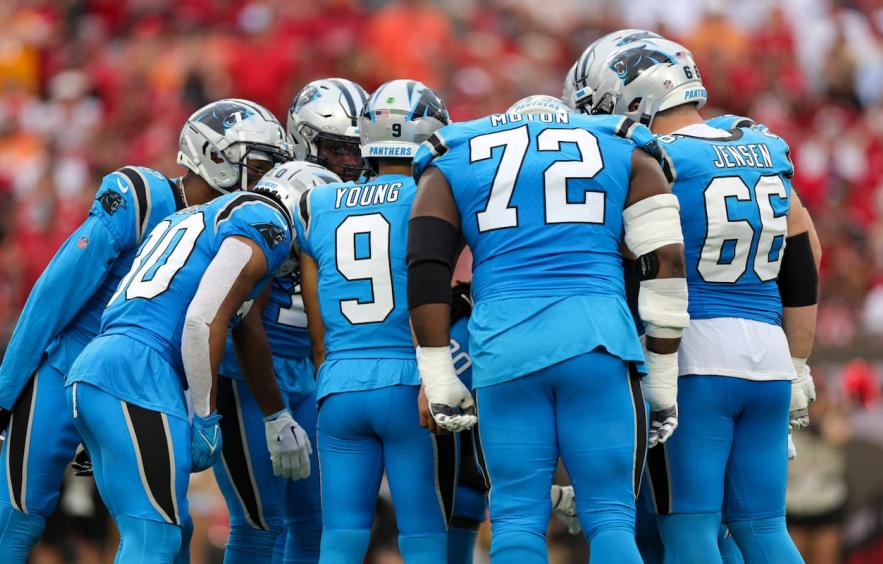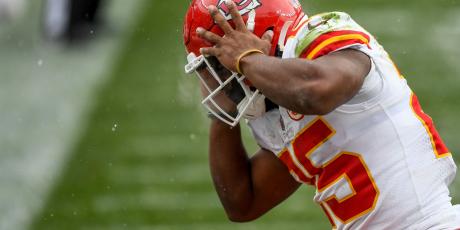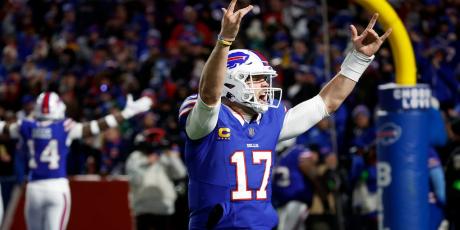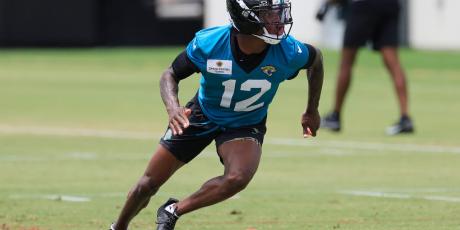Which Teams Invested in the Offensive Line in 2024?

Don’t forget about the trenches. Offensive line play is difficult to quantify and is often overlooked when evaluating fantasy environments.
Every offseason, once the main part of free agency is over, I compile all the offensive line free-agent signings to get a quantitative sense of which teams are investing in the trenches. One of the best measures of a player's value and ability is the contract that they sign, so I sum the average annual value for each team's free agents in (players the team signed) and free agents out (players signed away by other teams) to calculate a net dollar value (net $ in) for each team.
I don’t think anyone else looks at free agency this way, but if they do, please let me know–I’d be interested to see their analysis.
A team with a large positive number means they brought in significantly more talent than they lost, and the team should be better up front. Conversely, a team with a big negative number means that they lost considerably more talent than they brought in, and the team’s offensive line should be worse. Quality coaching, good drafting, and the development of younger players can offset these losses in free agency.
I've been studying offensive line spending since the 2019 season and generally speaking, teams that lead the league in offensive line free agency spending will see an improvement in run-blocking and pass-blocking. It's not for certain, however, as there are other factors at play like a deep bench, quality/poor coaching, injuries, etc. For an overview of the 2019-2022 data, check out last year's version of this article.
Note: I previously used Football Outsiders' Adjusted Line Yards and Adjusted Sack Rate, but since that data is behind a paywall now, I'll be using ESPN's advanced stats–Pass Block Win Rate (PBWR) and Run Block Win Rate (RBWR)–along with Pass Blocking Efficiency (PBE) from PFF to measure improvement in offensive line play.
In 2023, four teams spent a net of $10 million or more on the offensive line.
-
The Broncos (+$23.6M) finished third and eighth in RBWR and PBWR after finishing third and ninth, respectively, the year before. They were able to maintain good offensive line play despite not drafting a lineman in the first three rounds. Denver’s PBE improved from 20th in 2022 to eighth last year.
-
The Bengals (+$17.1M) were 9th and 27th in RBWR and PBWR after finishing eighth and 30th, respectively, the year before. Cincinnati’s spending didn’t make much of a difference in these metrics. According to PFF, the Bengals’ PBE actually declined from 14th to 21st.
-
The Commanders (+$11.4M) spent in free agency but also drafted Ricky Stromberg in the third round. They finished 22nd and 14th in RBWR and PBWR after finishing 16th and 27th the year before. Per PFF, they improved from 31st to 25th in PBE.
-
The Steelers (+$10.7M) finished 12th and 17th in RBWR and PBWR after finishing eighth and seventh, respectively, in 2022. Their PBE slipped from seventh to 24th per PFF.
In 2023, three teams had a net loss of $10 million or more in free agency.
- The Eagles (-$17.7M) finished first and seventh in RBWR and PBWR in 2023 after finishing second and ninth, respectively, the year before, so they actually improved in those metrics despite losing talent in free agency. However, at PFF the Eagles’ PBE was 14th after a second-place finish in 2022. Last year I said that the “Eagles’ offensive line should continue to be solid since they addressed their losses in the draft and have plenty of depth.”
-
The 49ers (-$16.9M) finished 23rd and 20th in RBWR and PBWR in 2023 after finishing 16th and 19th, respectively, the year before. Their PBE fell to 23rd after a fifth-place finish in 2022. Last year I noted that back-to-back net losses in free agency meant that “this unit’s loss of talent might start to sting.”
-
The Ravens (-$13.5M) finished fifth and ninth in RBWR and PBWR in 2023 after finishing first and fifth, respectively, the year before, so they took a slight step back in these metrics. Per PFF, their PBE fell from seventh to 10th year over year. Last year, I noted that “Baltimore has depth along the line, so the Ravens should be fine.”
Here's a look at the table for 2024.
| Team | Net # In | Net $ In | Rank | Drafted In First Three Rounds | Net Players In |
|---|---|---|---|---|---|
| CAR | 2 | $36,125,000 | 1 | 0 | 2 |
| WAS | 4 | $19,683,333 | 2 | 1 | 5 |
| ARI | 2 | $17,350,000 | 3 | 1 | 3 |
| NYG | 2 | $15,635,000 | 4 | 0 | 2 |
| LAR | -2 | $11,720,000 | 5 | 0 | -2 |
| NYJ | 0 | $8,540,000 | 6 | 1 | 1 |
| JAX | 1 | $5,250,000 | 7 | 0 | 1 |
| TEN | -2 | $3,442,500 | 8 | 1 | -1 |
| NO | 2 | $2,402,500 | 9 | 1 | 3 |
| SF | 1 | $1,352,500 | 10 | 1 | 2 |
| PHI | 0 | $1,335,000 | 11 | 0 | 0 |
| TB | 0 | $1,307,500 | 12 | 1 | 1 |
| NE | 1 | $1,025,000 | 13 | 1 | 2 |
| IND | 0 | $0 | 14 | 1 | 1 |
| LAC | 0 | -$167,500 | 15 | 1 | 1 |
| CLE | 1 | -$260,000 | 16 | 1 | 2 |
| CHI | 0 | -$417,500 | 17 | 1 | 1 |
| ATL | -1 | -$1,750,000 | 18 | 0 | -1 |
| BUF | 1 | -$2,207,500 | 19 | 0 | 1 |
| MIN | -2 | -$2,722,500 | 20 | 0 | -2 |
| LV | 0 | -$3,650,000 | 21 | 2 | 2 |
| PIT | -1 | -$4,000,000 | 22 | 2 | 1 |
| KC | -1 | -$5,333,333 | 23 | 1 | 0 |
| SEA | 1 | -$7,230,000 | 24 | 1 | 2 |
| HOU | -3 | -$8,140,000 | 25 | 1 | -2 |
| DEN | 1 | -$10,152,500 | 26 | 0 | 1 |
| BAL | -1 | -$10,210,000 | 27 | 1 | 0 |
| CIN | 0 | -$10,250,000 | 28 | 1 | 1 |
| MIA | 1 | -$11,210,000 | 29 | 1 | 2 |
| GB | 0 | -$12,080,000 | 30 | 1 | 1 |
| DET | -1 | -$12,292,500 | 31 | 0 | -1 |
| DAL | -3 | -$18,000,000 | 32 | 2 | -1 |
A Few Takeaways
For the teams, I’ll list their ranks for RBWR, PBWR, and PBE in parentheses. For certain players, I’ll mention their positional run/pass-blocking ranks per PFF. There were 90 eligible tackles, 85 eligible guards, and 39 eligible centers last year, based on at least 20% of the snaps played.
-
Since I began tracking this data in 2019, the Panthers (30th in RBWR, 23rd in PBWR/27th in PBE) spent the most in free agency (+$36.1M) on the offensive line–by a wide margin–outspending the 2023 Broncos by nearly $13 million. They signed guard Robert Hunt (10th in run blocking grade, 10th in pass blocking grade) away from Miami, guard Damien Lewis (47th, 32nd) away from Seattle, and tackle Yosh Nijman away from the Packers. Bryce Young should have more time to throw in his second season and Jonathon Brooks should enjoy better run-blocking than the Panther running backs did last season.
-
The Commanders (22nd, 14th/25th) were once again big spenders (+$19.7M) in free agency and they used a third-round pick on tackle Brandon Coleman. Washington added center Tyler Biadasz (17th, 15th) and guard Nick Allegretti. Biadasz should help immediately, while Allegretti’s career has been up and down through five seasons. The Commanders’ offensive line might graduate from mediocre to decent this year.
-
The Cardinals (6th, 19th/19th) made two big investments in the offensive line by signing tackle Jonah Williams (65th, 68th), who is coming off his worst season as a pro, and drafting guard/tackle Isaiah Adams in the third round. Arizona is hoping to maintain good run-blocking while providing better protection for Kyler Murray.
-
The Giants (31st, 24th/30th) needed a lot of help on the offensive line. They signed guard John Runyan (66th, 31st) and tackle Jermaine Eluemunor (23rd, 49th), so they should be more competent up front, though they have a long way to go to even get to mediocre.
-
If you're looking for a unit that can make a quick turnaround, check out the Jets (29th, 30th/31st), who added guard John Simpson (52nd, 36th), tackle Tyron Smith (25th, 1st), and drafted tackle Olu Fashanu with the No. 11 overall pick. They also traded for Ravens tackle Morgan Moses (10th/21st). It’s clear that the Jets prioritized pass protection (and the offensive line in general) this offseason. If Smith can stay healthy and Fashanu develops quickly, this unit could improve very quickly. Breece Hall should have an excellent season and Aaron Rodgers should be well-protected after a lost season in 2023.
-
The Cowboys (4th, 16th/4th) lost $18 million in salary by losing center Tyler Biadasz, tackle Tyron Smith, and tackle La’el Collins. However, they used two premium picks on linemen, adding tackle Tyler Guyton in the first round and guard Cooper Beebe in the third. If they hit on both of their rookies, this unit should continue to be strong.
-
The Lions (13th, 13th/13th) replaced Jonah Jackson with Kevin Zeitler (37th, 2nd) who is six years older but had higher blocking grades at PFF. If Zeitler can stay healthy and maintain quality play, this line could be even better despite a sizable net loss of salary in free agency.
-
The Packers (16th, 2nd/9th) lost guard John Runyan and tackle Yosh Nijman, but added tackle Andre Dillard, who is coming off his worst season as a pro. David Bakhtiari isn’t showing up in their numbers because he hasn’t signed elsewhere, though he barely played last season, so he wasn’t a part of the unit’s success. The Packers used a first-round pick on versatile tackle Jordan Morgan. Green Bay generally does a good job of developing their linemen so the unit should have another good season provided Morgan can contribute.
-
The other four teams with a net loss of $10 million or more were the Dolphins, Bengals, Ravens, and Broncos. The Broncos were the only team that didn’t use a premium draft pick on a replacement lineman.





















